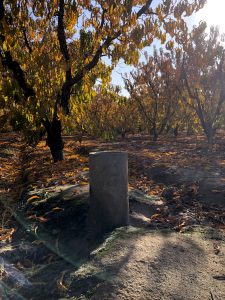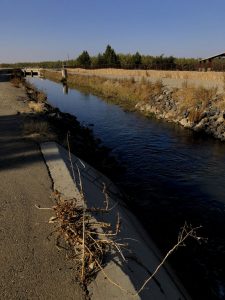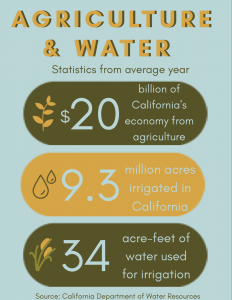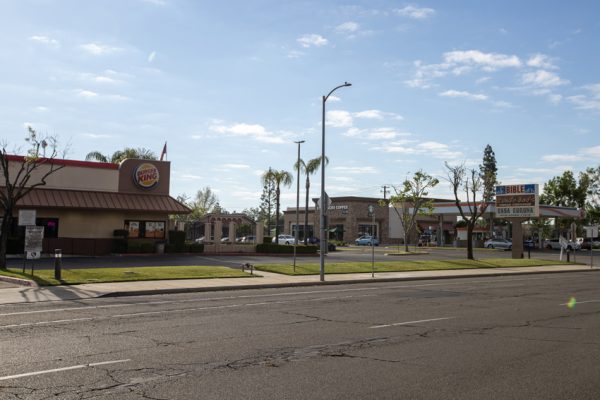Drought affects production, prices of No. 1 food producing state
This article is the first in a three-part series about agriculture in The Valley. Interviewing various professionals and farmers, Toryn Triplitt will continue this series about issues and news within the agricultural and farming community.

California produces around $47 billion worth of food and produce annually, which ranks the state as number one in regards to food production. The second state is Iowa, which is $20 billion behind the golden state. California grows over 230 different crops.
California produces 13% of all cash crops for the United States, but it is the sole producer of various crops that can not be grown anywhere else in the nation with the same success rate. These crops include: apricots, dates, almonds, kiwi, olives, pistachios, walnuts and more. California leads the nation in the production of: avocados, strawberries, lemons, grapes, peaches and plums.
The Central Valley, which houses Fresno’s home, the San Joaquin Valley, stretches 450 miles long and 60 miles at the widest point. The valley itself is larger than nine different states, but the Valley offers many bragging rights.
The Valley is home to the world’s largest patch of class one soil. The sun shines around 300 days of the year, and the 25-degree temperature range every day is ideal for crops. The cool winters, that bring no snow, offer opportunities to grow plants that handle the scorching summer heat.
For being such an agricultural hotspot, farmers face many different obstacles and concerns. In some cases, this refers to laws and regulations that can make production difficult but, some of the concerns are environmental.
One major concern in the last 10 years was the drought that lasted from 2011-2019. The drought itself had many effects on plants and farming. The drought affected crop yield and profit. The California drought was declared a state of emergency in 2014.

In 2017, Governor Jerry Brown announced that the drought was over, due to first wet winter the state had experienced since the beginning of the dry spell. Both commercial and residential “water wasters” would face a fine of up to $500 a day. During this time, many agricultural jobs would be lost and money would be lost trying to keep fields producing at the same level.
Farmers were not a priority to receive water, and eventually, they were only receiving 5% of the requested water, due to this, produce from the Central Valley had major price inflation. Wildfires ravaged the state at a much higher risk than usual. With many other effects ranging from short term to long term concerns.
A local area farmer, John Nale, grows a variety of crops, including grapes for raisins, wine grapes, almonds, walnuts, french plums, peaches, plums and nectarines. His family also has a winery called Ziveili. The drought hit the Nales hard when they began having water issues with their wells.
“The biggest concerns of the drought came to light in 2014,’15,’16,” Nale said. “As our old agricultural wells dried up and our family spent thousands and thousands upon thousands of dollars on drilling new ones, we are now chasing the falling water table.”
Having to drill new wells is a major issue in-and-of-itself, but as they continued drilling wells they encountered even more problems. They eventually hit the water, but it was water that contained carbonates. Carbonates can damage the soil’s productivity by influencing pH structures and water flow. The carbonates in the water they were using eventually damaged the soil by creating a seal that water could not pass.
[media-credit id=139 align=”alignleft” width=”232″] [/media-credit]
[/media-credit]
“Ultimately, we dug such a deep well on one ranch we hit the water that was full of carbonates,” Nale said. “Not realizing what was in the water, we pumped for six months thinking we were irrigating the walnut trees. In actuality, we were deficit irrigation because the carbonates created a seal about 18 inches deep in the soil. The seal is a layer of dirt that would not let water pass below it.”
This seal led to a lower crop yield when the temperatures began to rise. Because it was hotter, the roots needed more water to keep the plants alive. Because there was no water below the 18-inch seal, the crops could not yield as much fruit.
“When the temperature hits 100 degrees or more, the trees started dropping crop,” Nale said. “There was not any water in the soil profile below 18 inches so all the roots below that layer couldn’t supply any water to the tree when it got hot. The tree responded by dropping fruit. We harvested half a crop that year. We figured this out two months before harvest, too late to do anything but stop using our new and super expensive well.”
California was just officially declared drought-free after last winter. In the spring of 2019, the state displayed the lowest amount of dry land in years, officially declaring the state drought-free. The drought lasted 376 weeks, roughly around seven years.
Mindi Weber, a senior vice president commercial banking leader at Wells Fargo, discussed some of the new regulations that are to be enforced. She spoke about the Sustainable Groundwater Management Act (SGMA) which is the efforts to make above ground, water storage as sustainable as possible, and to regulate the use of it.
“What was happening is the water that was being pulled out of the ground for the irrigation of those plants was not going back through the ground and recharging the aquifer,” Weber said. “So we were seeing a decrease in those aquifer numbers.”
In the following podcast, Weber discusses the financial impacts this will have on not only farmers, but civilians and other jobs.
Another issue California farmers face is soil degradation. More specifically, soil salinity. Salinity is a global issue, but it has become pressing in the San Joaquin Valley, because of its use of irrigation to supply water to fields. California leaders have been seeking out ways to prevent it from getting too bad.
California has a complex water movement and irrigation system. The drought was one reason that the soil salinity increased in the Valley. The quality of the water that was being irrigated decreased, as well as the amount received.
The decrease in water supply meant less water was available to leach salt already residing in the soil. The concentration of salt increased as an effect. When the salt level is higher, it makes it harder for the plant to retain the amount of water it needs. Irrigated water contains higher levels of salt.
With most of the Valley’s crop water supply being supplied by irrigation, the water contains higher salt levels than other water sources.
Plants do require a certain amount of salt, but too much is dangerous. Side effects of soil salinity can be; loss of the crop, decrease in the sustainability of soil, floods, erosion and more. Because of the valley’s structure, there is no outlet to deposit the excess salt that accumulates. Whereas near the coast, they are able to directly deposit it into the ocean.
Many other environmental factors pose threats or issues for California’s agriculture production. The California Department of Food and Agriculture updates the public on the environment, wildlife and weather conditions regularly. They also provide knowledge on many different regulations farmers throughout the state must follow. They cover many other topics underneath the broad umbrella that is California Agriculture.
To help keep Californian farmers farming through all these regulations, consider ways to conserve water, despite the end of recent drought! Continue to support local farmers and make sure to stay updated with the various changes in Fresno agriculture.
For more articles, read Hallie Rojeski prepares eighth grade students for 31st annual U.S. Constitution test or Chamber choir to perform in Disneyland Candlelight Concert, Dec. 8.
Toryn Triplitt can be contacted via email.











![[Video] 100th CSPA Spring Journalism Conference](https://thefeather.com/wp-content/uploads/2024/04/20240308-cspa-crown-002.jpg)





